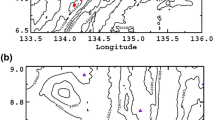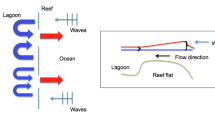Abstract
Current data were collected at 3 stations in the Great Barrier Reef Lagoon of Australia between Lizard Island and Carter Reef, an outer ribbon reef, (approximately 14°S) over a 2 year period. During the southeast Trade wind season (March–September), net circulation at all stations was to the northwest, parallel to the coast and reefs, with little cross-shelf movement. This motion was periodic at about 20 days and highly coherent with the wind. During the non-Trade wind season (October–February) the net circulation depended on the variable wind regime and exhibited frequent current reversals and cross-shelf motion. Tidal currents were superimposed on the net circulation and were mainly cross-shelf but with a tidal excursion of only about 5 km on a flood tide. Tidal currents close to Carter Reef were not cross-shelf but remained parallel to the reef, suggesting that the major tidal flux is through the reef passages. Net circulation close to Carter Reef was not coherent with net circulation at the stations in more open waters, during both Trade and non-Trade seasons. Current speeds were typically 10–30 cm s-1. Passive plankters entering the water from Carter Reef are therefore likely to remain close to the outer ribbon reefs and be moved parallel to them. Based on the above, we predict that in the Trade wind season, passive plankters would be advected further from their point of origin than during the non-Trade wind season, but there would be more cross-shelf advection during the latter.
Similar content being viewed by others
References
Andrews JC (1983a) Thermal waves on the Queensland shelf. Aust J Mar Freshwater Res 34:81–96
Andrews JC (1983b) Water masses, nutrient levels and seasonal drift on the outer central Queensland shelf (Great Barrier Reef). Aust J Mar Freshwater Res 34:821–834
Church JA, Boland FM (1983) A permanent undercurrent adjacent to the Great Barrier Reef. Phys Oceanogr 13:1747–1749
Cunningham A (1981) Currents recorded by two current meters at Lizard Island, North Queensland, Australia, BSc (Hons) thesis, University of New South Wales
Leis JM (1986) Vertical and horizontal distribution of fish larvae near reefs at Lizard Island, Great Barrier Reef. Mar Biol (in press)
Leis JM, Goldman B (1983) Studies on the biology of larval fishes in the Lizard Island area, Northern Great Barrier Reef. In: Baker JT, Carter RM, Sammarco PW, Stark KP (eds) Proceedings Inaugural Great Barrier Reef Conference, Townsville, 1983. J Cook University Press, Townsville, pp 221–225
Leis JM, Goldman B (1984) A preliminary distributional study of fish larvae near a ribbon coral reef in the Great Barrier Reef. Coral Reefs 2:197–204
Middleton JH (1983) Low-frequency trapped waves on a wide, reef-fringed continental shelf. Phys Oceanogr 13:1371–1382
Middleton JH, Cunningham A (1984) Wind-forced continental shelf waves from a geographical origin. Cont Shelf Res 3:215–232
Middleton JW, Thomson B (1985) Steady wind-driven coastal circulation on a B-plane. Phys Oceanogr 15:1809–1817
National Tide Tables Australia (1984) Navy Hydrographic Office, Canberra
Pickard GL, Donguy JR, Henin C, Rougerie F (1977) A review of the physical oceanography of the Great Barrier Reef and Western Coral See. AIMS Monog Ser, vol. 2. Aust Govt Publ Service, Canberra
Pond S, Pickard GL (1983) Introductory dynamical oceanography, 2nd edn. Pergamon, Oxford
Thompson RORY, Goldin TJ (1981) Tidally induced “upwelling” by the Great Barrier Reef. J Geophys Res 86:6517–6521
Walker JA (1982) Lack of evidence for evaporation-driven circulation in the Great Barrier Reef Lagoon. Aust Mar Freshwater Res 33:717–722
Williams DMcB, Wolanski E, Andrews JC (1984) Transport mechanisms and the potential movement of planktonic larvae in the central region of the Great Barrier Reef. Coral Reefs 3:229–236
Wolanski E, Bennet AF (1983) Continental shelf waves and their influence on circulation around the Great Barrier Reef. Aust J Mar Freshwater Res 34:23–27
Wolanski E, Pickard GL (1983) Upwelling by internal tides and Kelvin waves at the continental shelf break on the Great Barrier Reef. Aust Mar Freshwater Res 34:65–80
Wolanski E, Ruddick B (1981) Water circulation and shelf waves in the Northern Great Barrier Reef Lagoon. Aust J Mar Freshwater Res 32:721–740
Author information
Authors and Affiliations
Rights and permissions
About this article
Cite this article
Frith, C.A., Leis, J.M. & Goldman, B. Currents in the Lizard Island region of the Great Barrier Reef Lagoon and their relevance to potential movements of larvae. Coral Reefs 5, 81–92 (1986). https://doi.org/10.1007/BF00270356
Accepted:
Issue Date:
DOI: https://doi.org/10.1007/BF00270356




